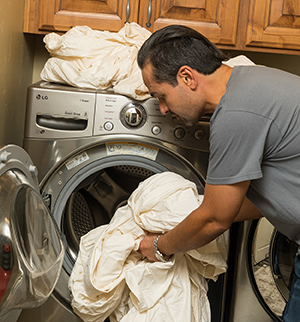Scabies
Scabies is an infection caused by very tiny mites that burrow into the upper layer of skin where they live and lay eggs. The mites cause severe itching. Children are most commonly infected, but anyone can get scabies. Scabies mites can pass from person to person through close physical contact. They can also be passed through shared clothing, towels, and bedding. Scabies infection is not usually dangerous, but it is uncomfortable. Because it's so contagious, scabies should be treated right away to keep the infection from spreading.
Symptoms
Symptoms of scabies appear about 4 to 8 weeks after infection in a child or adult who has never had scabies before. A child or adult who has been infected before will have symptoms much sooner, in 1 to 4 days. Signs of scabies infection may include:
-
Intense itching, especially at night or after a hot bath
-
Skin irritations that look like hives, insect bites, pimples, or blisters, especially on warmer areas of the body, such as between the fingers, in the armpits, and in the creases of the wrists, elbows, and knees
-
Sores on the body caused by scratching. The sores may become infected.
-
Burrows created by mites traveling under the skin. These look like lines on the skin’s surface.
Treating scabies infection
Scabies infections are usually treated with a prescription lotion that kills the mites. The lotion must be applied to the entire body from the neck down. This includes the palms of the hands, soles of the feet, groin, and under the fingernails. The lotion must be left on for 8 to 14 hours or as prescribed. The lotion is often used at night before bed and then washed off the next morning. In some cases, the child or adult may need a second application of lotion a week after the first. Medicines work quickly to kill the mites, but most children and adults continue to have an itchy reaction to the bites they've already gotten for several weeks after treatment. Marks on the skin from scabies usually go away in 1 to 2 weeks, but sometimes they take a few months. If the skin creams don't work, the child or adult may need to take medicine by mouth (orally).
Preventing the spread of the infection
 |
| To prevent spread of infection, wash clothing, linens, and toys in very hot water. |
To prevent reinfection and the spread of scabies to others, follow these instructions:
-
Wash the infected person’s clothing, towels, bed linens, cloth toys, and other personal items in very hot, soapy water. Dry them thoroughly in a dryer set on hot. If an item cannot be laundered, have the item dry cleaned. Don't share items among family members.
-
Seal items that can’t be washed in plastic bags for at least 3 days and possibly up to 1 week.
-
Vacuum floors and furniture. Throw the vacuum bag away afterward.
-
Tell an infected child’s school and caregivers so that other children can be checked and treated.
-
Keep an infected child home from daycare or school until the morning after treatment for scabies.
-
Warn children not to share items such as clothing and towels with other children.
-
Be aware that all household members who may have been exposed to scabies may need to be treated, even if they don't have symptoms. Talk with your healthcare provider.
-
Don't spray your house with chemicals or pesticides. These can be dangerous to your family’s health.
When to call your healthcare provider
Call your healthcare provider right away if you or a family member has any of these:
-
Fever of 100.4°F (38°C) or higher, or as directed by your provider
-
Red streaks, pain, or swelling of the skin
-
Yellow or brown crusts or drainage from the sores
-
Sores that get worse or do not heal
-
New rashes appear or itching continues for more than 2 weeks after treatment
Online Medical Reviewer:
L Renee Watson MSN RN
Online Medical Reviewer:
Michael Lehrer MD
Online Medical Reviewer:
Rita Sather RN
Date Last Reviewed:
12/1/2022
© 2000-2024 The StayWell Company, LLC. All rights reserved. This information is not intended as a substitute for professional medical care. Always follow your healthcare professional's instructions.